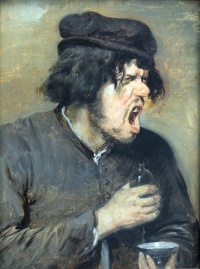I’ve been reading up on the grotesque body, finally taking the trouble and the time to read how its ‘inventor’ Mikhail Bakhtin defined it.
Here you have it, from Rabelais and His World:
“Contrary to modern canons, the grotesque body is not separated from the rest of the world. It is not a closed, completed unit; it is unfinished, outgrows itself, transgresses its own limits. The stress is laid on those parts of the body that are open to the outside world, that is, the parts through the world enters the body or emerges from it, or through which the body itself goes out to meet the world. This means that the emphasis is on the apertures or convexities, or on various ramifications and offshoots: the open mouth, the genital organs, the breasts, the phallus, the potbelly, the nose. The body discloses its essence as a principle of growth which exceeds its own limits only in copulation, pregnancy, childbirth, the throes of death, eating, drinking, ordefecation. This is the ever unfinished, ever creating body, the link in the chain of genetic development, or more correctly speaking, two links shown at the point where they enter into each other. This especially strikes the eye in archaic grotesque”. (tr. Helene Iswolsky)
It’s quite a beautiful piece of prose. It reminds me of Deleuze and Guattari saying “there is no castration” and Sloterdijk’s genius comment on the the arse: “the arse is truly is the idiot of the family.”
See embodied cognition, body genres and body politics.
Also, anything coming out of the mouth of a ‘wise fool‘: morosophy and its mutant siblings serio ludere and spoudaiogeloion are still of great interest to yours truly.

.jpg)





